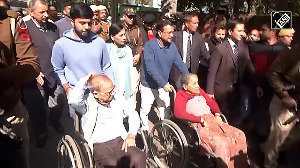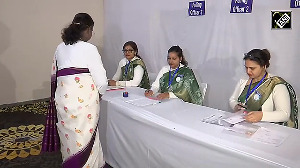Finance Minister P Chidambaram spoke at length on farm loan waiver guidelines and what they seek to achieve. Here are the edited excerpts:
On the beneficiaries
Our initial estimates placed the number of beneficiaries as 30 million small and marginal farmers and 10 million 'other farmers'.
As it turns out, the number of small and marginal farmers is more than 30 million and it is estimated that the number is likely to be 36.90 million, while the number of other farmers is estimated about 5.97 million.
These are verified but as yet unaudited figures. Initially, in the Budget, it was estimated that the cost of the scheme will be about Rs 60,000 crore (Rs 600 billion) to the central government.
As it turns out, the cost of the scheme is likely to be in the order of about Rs 71,680 crore (Rs 716.8 billion), again unaudited. After audit, there may be some reduction.
On its size
In terms of scope, coverage and the financial cost, this is the most ambitious scheme ever undertaken by any government in India.
The guidelines will be circulated to the scheduled commercial banks, the regional rural banks and the cooperative credit institutions today. I will write to the Chief Ministers today. A copy of the guidelines will be available in the hands of every branch manager of every lending institution.
Every branch of a public sector bank, every branch of a scheduled commercial bank, every branch of a RRB and every branch of a cooperative lending institution by the end of this month. They will have 30 clear days to implement the scheme. And the scheme will be implemented by June 30, 2008.
The broad features:
Marginal farmer are defined as cultivating agricultural land up to 1 hectare. A small farmer is defined as cultivating between 1 hectare and 2 hectares. They will get full debt waiver of their short term crop loans as well as all the overdue instalments on the investment credit.
The other farmers, those owning over 2 hectares, will get one time settlement relief. The point to remember is, on an average, in most states, the small and marginal farmers account for between 70 to 94 per cent of all farmers.
So, if you are a small and marginal farmer, all the short term crop loans which are overdue and the instalments are overdue will be return off. Between 70 and 94 per cent is the range for all states.
In many states, it is over 80 per cent. So, these farmers will get full debt waiver. As far as the other farmers, you would remember that in the budget speech, I had announced that 25 per cent of the overdue will be given to them. And they have to pay the balance 75 per cent.
It was brought to our notice that in dry and unirrigated areas of India holdings are usually more than 2 hectares, and if you limit the relief to 25 per cent, a large number of farmers will not get adequate relief.
They will get relief of 25 per cent but they may not be adequate. Now, we came to the conclusion that this is a legitimate demand and this has to be addressed.
On how the demand was addressed
We have addressed it in the following manner: ll dry and unirrigated lands in this country, at least a bulk of it, falls in districts which are covered under the drought prone area programme.
Such land also falls under another called the desert development programme. These two programmes have been in operation for many years. And the number of districts covered under these programmes have been updated from time to time.
Not all blocks in the district are covered. For example, DPAP extends to 188 revenue districts but only to 972 blocks in those districts.
DDP extends to 40 districts but only to 235 blocks in the district. Then there are 31 districts identified under PM's special relief package of 2006 as debt stressed districts. If you add the total, you come to 259 revenue districts, if you count the overlap out, then there are 237 discrete districts.
In these 237 districts, irrespective of the fact that only some blocks fall under DPAP and DDP, we are taking the whole district as falling under dry and unirrigated districts.
So, out of 596 rural districts of India, 237 districts have been taken for the purpose of the scheme as having mostly dry and unirrigated land and the benefit that is announced in the budget is being improved upon in these districts, the OTS relief will not be 25 per cent, the OTS relief will be 25 per cent or Rs 20,000 whichever is higher.
On how farmers benefit
Therefore, if a farmer's overdue was Rs 20,000 under the original package he would have had Rs 5,000, today the farmer will get Rs 20,000 write off. If earlier the farmer's outstanding was Rs 60,000, under the earlier package, he would have got Rs 15,000, today he will get Rs 20,000 written off.
Now, please remember small and marginal farmers account from between 70 per cent to 94 per cent. They are anyway getting full relief. Other farmers, larger farmers are only 30 per cent to 6 per cent.
We have found that on an average, the larger farmer, with more than 5 acres, these areas have a short term crop loan of about Rs 19, 908 and the average size of the investment loan is Rs. 13,224.
If you take these numbers according to our calculation, roughly 60-65 per cent of large farmers in these 237 districts will get not 25 per cent relief, but full debt waiver. Because the debt waiver is now Rs 20,000 whichever is higher.
Therefore, we have on the one hand, all the small and marginal farmers getting full debt waiver in 237districts and other farmers roughly 60-65 per cent will also get full debt waiver. The others of course will get 25 per cent of their overdue amount.
This is the reason why the cost of package has increased to some extent but central government, UPA government has already approved this package in order to give maximum relief to the maximum of farmers to the extent it is doable and feasible.
On the implementation
The scheme itself is being implemented in a very simple manner. Already instructions have been issued. And each branch has prepared both in hard copy and soft copy a list of the borrowers in that bank who are entitled to either debt waiver or debt relief. These lists are ready.
These are tentative lists. Once the guidelines reach the bank manager, the bank manager has to now prepare two lists. One list of small and marginal farmers who will get full debt waiver.
The name of the farmer, the amount of loan that is outstanding against him and the full debt waiver will be put up in that list. The second list will consist of other farmers, OTS relief 25 per cent and in some districts 25 per cent or Rs.20,000 whichever is higher.
The two lists will be finalized and the list will be put up on the notice board of the branch of the lending institution. Any farmer can simple walk up to the bank branch and look at the list. He will find his name in either in debt waiver list or the debt relief list, and amount of debt waiver or the debt relief will also be published in that list.
That is the end of the matter. Immediately the bank will issue to the small and marginal farmer, a certificate of debt waiver mentioning the amount of debt that has been waived and take an acknowledgement from him. There is no application, no certification, no documents to be attached, nothing.
The list will be prepared by the bank, put on the notice board and the debt is waived. The other farmer will look at the list and know how much is the relief granted to him. The balance 75 per cent he has to pay. And we are providing that he can pay the balance in three instalments on or before June 30, 2009.
And up to 30th June, 2009, no interest has been charged on the outstanding amount of the other farmer. So he need not pay any interest either. The amount is mentioned there, 25 per cent the central government will pay to the bank, and 75 per cent the farmer will pay in three instalments.
On any problems
If a farmer has a complaint, if his name is not in the correct list or his name is not in the list at all, he can give a complaint to the grievance redressal officer. Every bank has been asked to appoint as many grievance redressal officers as necessary having regard to the number of branches in each district in his zone.
He can send the complaint to the bank or directly to the grievance redressal officer. These will be compiled and monitored. All grievances will be disposed of within 30 days.
That was a very simple mechanism without any hassle to the farmer and the moment the debt waiver is done and the debt relief is done, a certificate is issued by the branch to the farmer that he is being given either debt waiver or is being given debt relief.
We have already sensitised the national banks, the scheduled commercial banks and the RRBs. We have also taken meetings to sensitise the cooperative institutions.
As you are aware, the cooperative institutions fall under the administrative control of the state governments, I am writing to Chief Ministers, to ensure that the senior officers of state governments travel all over the State and facilitate the implementation of the debt waiver and the debt relief scheme.
On its accuracy
A hard copy and soft copy of the list of beneficiaries are mandated to the made available. These will be compiled lending institution wise, i.e. bank wise and will be made available to Nabard and RBI. These lists will be subjected to auditing.
There is a concurrent audit, then there is a statutory audit and if in a particular case, it is necessary to order a special audit, the central government will order a special audit. Based on the audit, the claims of the bank of the central government would be reimbursed to the banks as I said they will be reimbursed over a period of three years.
This year itself, we will provide Rs 40,000 crore (Rs 400 billion), the next year and the next year, the balance will be provided.
The key to the implementation of the scheme is the integrity and accuracy of the lists. So, we have impressed upon all bank chairman and chief executives that they have to take responsibility for the accuracy and integrity of lists.
There can be errors of inclusion, there can be errors of exclusion. Both errors must be eliminated. And each list must be signed by an authorized officer of a fairly senior rank.
So, chief executives of the bank have been sensitized that the lists are paramount, they have to be authorized, signed and certified by the senior officer of the bank. There still will be some errors. These errors when pointed out by complaints or grievance to the grievance redressal officers, I assure the farmers that these grievances will be addressed promptly and it will be attended to at appropriate orders passed within 30 days of the receipt of their grievance.
On the completion
I am confident that we can implement this scheme successfully on the 30th of June, 2008. I am confident that nearly 43 million farmers will get the benefit of debt waiver which will be about 70 to 94 per cent depending upon the proportion in that State and the remaining will get debt relief. I am sure that you will want to ask questions on the guidelines.
On the fine-print
I have only two requests. Please go through these guidelines and then I will meet you again on Monday if necessary to answer any question. I think raising question without reading the guidelines will mean that you are chasing a black cat in a dark room blind folded.
So I suggest you read the guidelines and come back. Secondly, don't yield to the temptation of picking a hole here or picking a hole there. I'll tell you why. You draft a scheme, I can always pick holes in that. Just as if I draft a scheme, you can pick holes. That's not the point.
On the nature of the scheme
The point is that a scheme of this nature has never been attempted before. The NDA government could not even contemplate a scheme of this kind. Six years they were in government, but they could not contemplate it. We had been able to muster the courage to launch such an ambitious scheme only towards the end of the fourth year.
Because this is a massive scheme, requires massive resources. Only when I was confident and the Prime Minister was confident that we have the resources to address the scheme, we were able to address the scheme. We have addressed a large part of the burden of the farmers. Please remember, when there is talk about food insecurity, need for food security, it is the farmers of India who are growing the food that you and I consume.
On India's farmers
I want to take this opportunity to compliment the farmers for the extraordinary results they produced this year. This is the year where we will have the highest procurement of wheat. The highest procurement of wheat ever in independent India. Our wheat procurement target was 150 lakh tonnes. We have already 207 lakh tonnes.
Roughly, 98.4 per cent of the wheat that arrived in Punjab Mandis has been procured by FCI. 99 per cent of the wheat that arrived in Haryana Mandis has been procured by FCI.
New States, not due States, we have had higher cooperation from States which were not procuring as much in previous years. Therefore, we have ample stocks of foodgrains -- wheat.
In rice again, procurement is very high. We have crossed 245 lakh tonnes and we hope to procure much more before the season ends till September 30. The farmers of this country deserve our support, deserve help and that's why the UPA government has come up with very ambitious debt waiver and debt relief scheme.
As I said in Parliament, we are discharging a debt that we owe to our farmers. Especially you and me who are non farmers, consuming people, we are discharging the debt that the non farmers owe to the farmers of the country.
On the banks
The central government is taking over the debt and reimbursing the banks. I also want to impress that the banks are in no way prejudiced. In fact, the debt is taken over effectively by the central government. And the banks will be reimbursed fully for the debt waiver and debt relief. Banks have by and large welcomed the scheme.
Monitoring the scheme
There will be a high level monitoring body at the national level which will be headed by the Secretary, Department of Financial Services. It will have as its members Secretary, Department of Agriculture, the Deputy Governor, Reserve Bank of India, Chairman of NABARD, Chairman and MD's of two public sector banks, Chairman of two RRBs and MD's of two state level cooperative banks.
This committee will monitor. I have asked all chairman, all EDs, all GMs to fan out throughout India in the month of June to ensure that the scheme is implemented. I have asked chief ministers, to our senior officers, I myself will travel to as many States as possible, to do a spot verification of how these lists are published on the Notice Board and to see whether farmers have access to this information so that they can satisfy themselves that their debt is either being waived or being given OTS relief.
Some details might be interesting. You can read it in the guidelines. Self help groups are covered. Joint liability groups are covered. Under short term production loan, we cover all loans given in connection with the raising of crops, where the repayment is 18 months.
Working capital loan up to 100,000 is covered. Under investment loan, this is of two kinds. One is investment credit for direct agricultural activities such as deepening of wells, sinking of new wells, installation of pump sets, purchase of tractors, purchase of bullocks, land development, plantations, horticulture. That is covered.
There is another investment credit from allied activities. This includes dairy, poultry farming, goatery, sheep rearing, piggery, fisheries, bee keeping, green houses and bio gas. They are covered. Loans that were restructured in 2004 and 2006 they are covered. Loans that are normally according to RBI guidelines, they are covered.
Suit-filed accounts:
In case of suit filed accounts, the instalments which are overdue are covered. Once the debt is waived on 30th of June 2008, fresh short term production loans will be available to all the farmers, it is available even now. But immediately after the loan waiver is done, fresh credit is available. In the case of investment credit, once the debt relief is announced on the notice board and the farmer pays one third of his share of 75 per cent he is entitled to fresh credit.
So the period February 29 2008 to June 30 2009, period during which the farmer has to pay his share, no interest will be shared. No further charges shall be levied by any bank upon any farmer.
For debt waiver and debt relief they will not charge any application money, interest charges, legal charges, nothing can be charged on the farmer. The money is frozen as on December 31, 2007 and the money will be put up in the list. No further charges can be claimed by the bank on the farmer. All claims by the bank must be upon the central government.
On the RBI's role
RBI is the nodal agency for the purpose of implementing the scheme. In the case of scheduled commercial banks, urban cooperative banks and local area banks. Nabard will be the nodal agency in respect of RRBs and cooperative credit institutions.
The only one paper which the farmer has to handle is the paper that he will receive, namely the certificate. The certificate shall be given to each farmer either of debt waiver or debt relief mentioning the amount.
The perforated second half of the certificate is the acknowledgement. The bank will give him the certificate and take the acknowledgement. That is the only paper which the farmer needs to take and keep in his possession.







 © 2025
© 2025